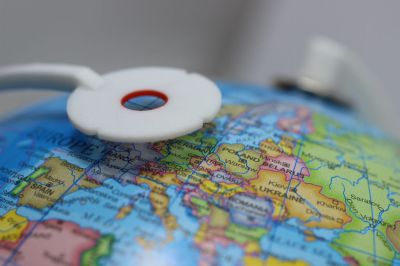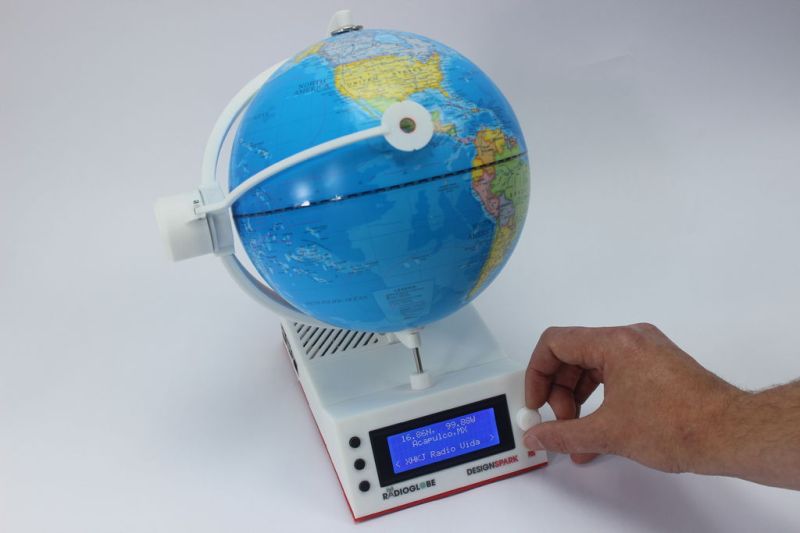There’s no denying that the reach and variety of internet radio is super cool. The problem is that none of the available interfaces really give the enormity of the thing the justice it deserves. We long for a more physical and satisfying interface for tuning in stations from around the globe, and [Jude] has made just the thing.
 RadioGlobe lets the user tune in over 2000 stations from around the world by spinning a real globe. It works by using two absolute rotary encoders that each have a whopping 1024 positions available. One encoder is stuck into the South Pole, and it reads the lines of longitude as the user spins the globe.
RadioGlobe lets the user tune in over 2000 stations from around the world by spinning a real globe. It works by using two absolute rotary encoders that each have a whopping 1024 positions available. One encoder is stuck into the South Pole, and it reads the lines of longitude as the user spins the globe.
The other encoder is on the left side of the globe, and reads whatever latitude is focused in the reticle. Both encoder are connected to a Raspberry Pi 4, though if you want to replicate this open-source project using the incredibly detailed instructions, he says a Raspberry Pi 3 B+ will work, too.
In the base there’s an LCD that shows the coordinates, the city, and the station ID. Other stations in the area are tune-able with the jog wheel on the base. There’s also an RGB LED that blinks red while the station is being tuned in, and turns green when it’s done. We totally dig the clean and minimalist look of this build — especially the surprise transparent bottom panel that lets you see all the guts.
There are three videos after the break – a short demo that gives you the gist of how it works, a longer demonstration, and a nice explanation of absolute rotary encoders. Those are just the tip of the iceberg, because [Jude] kept a daily vlog of the build.
Maybe you just long for a web radio that dials in vintage appeal. This antique internet radio has a lot of features, but you wouldn’t know it from the outside.















Oh wow! I would love to make one of these. Once the kiddo grows up a bit, this could be a great project to work on together that she can enjoy once it’s done.
I have a pre-schooler, and he had figured it out in minutes (you might see in the Q&A I did also: https://www.rs-online.com/designspark/radioglobe-qa-with-jude-pullen )
Here is an idea for v2:
Replace lcd with a touch screen and display a google maps (or another globe) zoomed to city where physical pointer points; allowing precise station selection. Basicly radio.garden on that display. Easy to say, though.
Yeah – you’re not wrong – easy to say! We did actually look at the ‘zoom’ function of doing this and there are OLED screen for RasPi as I’m sure you know. I think the ‘balance’ was the extra complexity to essentially duplicate RadioGarden, where as this is somewhat more about ‘casual discovery’, and not needing to always have a screen. I could honestly see these things being two different products, and both have different appeal. Thanks for comment tho!
Very ingenious interface.
It brings joy
:o)
For the radio only
http://radio.garden
If you liked that, you’ll love this: https://radiooooo.com/
And yes, not wrong, RadioGarden was inspiration…more here: https://www.rs-online.com/designspark/radioglobe-qa-with-jude-pullen
Thanks for the kind comment!
Excellent idea… good education tool as well.
Thanks – I have been doing Instructables, and other tutorials online and in person for some years.
Glad you saw the potential as a ‘101’ in some of the disciplines covered. =)
Check out Radiooooo.com for a musical journey through the years and nations.
OMG – yes it’s great. I did give a shout out already on the Q&A, which you might like…
https://www.rs-online.com/designspark/radioglobe-qa-with-jude-pullen
Interesting project, but take the plastic film off the LCD!
I think it should be possible to use a dot pattern printed on the globe surface and read by a camera to get the position with a single sensor, similar to livescribe pens. The trick would be coming up with a way to print the dot pattern on the globe.
Or maybe use the globe as a big trackball. Calibrate by starting from a specific position, and use the trackball reader to determine location of a pointer by dead reckoning.
I’d never take the plastic off until finished – that’s the best bit ;o)
The dot-code idea has been done, actually: https://www.youtube.com/watch?v=kc84r4LqPXU but good shout =)
We did also discuss ‘mouse ball’ – but if you’ve ever used one, they clog with detritus, so we felt that’d be risky, especially as gravity would work against us.
Always interesting to hear comments tho. Keep ’em comin’…
Indeed.. I’m also a compulsive plastic-remover but with maker projects I’m more careful. Don’t want a drop of solder melting into the display when you’re just finished soldering all 20 pins :D
Not to be a Debbie Downer, but I’ve been trying to figure out a way to identify news from around the world, (Yes, Virginia, news happens OUTSIDE of America.) I’d been trying to figure out how to keep the flood to a manageable stream. Then I saw Radiooooo and there map interface. Now with this, I can refine the interface even more.
Wow that sounds pretty cool. Glad its useful for you! Do post any updates or mods in Instructables/GitHub. Sounds interesting!
Congratulations on building the first ever attractive trackball interface ;-)
Thanks. As an ‘Engineer’ not a ‘Industrial Designer’ – I’ll take the compliment! Haha!
This is really cool. Inventive, looks great, even useful! :)
The maker spirit is strong in this one!
Thanks again! I’m excited to see where the Open Source party takes it….
DeathStar Radio would be a good follow-up.
We’d get some good punning with that…
Reader’s Digest made a globe that had a light that you could adjust a light spot on to any point on the globe, that would be a perfect addition to this.
Wow – that takes me back! My dad used to buy those books. xD
I love this. I also want to build one for my child!
My son love it! Go for it!
I bet that it will not tune station in Freedonia or The Islets of Langerhans.
Ahhhh GCSE Biology. Takes me back. Such a weird name, huh.
We were also looking to do an easter egg, perhaps around Bermuda Triangle.
So clearly, we share the same sense of (or lack of) humour…
I like this, I am thinking a brass version with a magnifying bubble as the viewfinder and a small 1″ round CRT display for feedback. Very steampunkable. Thanks for sharing the cool project.